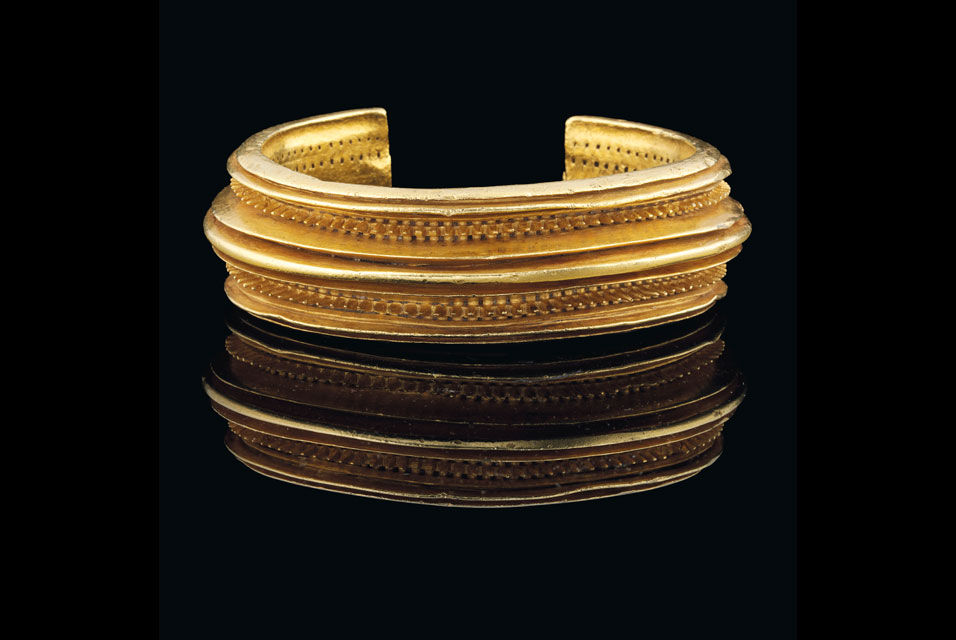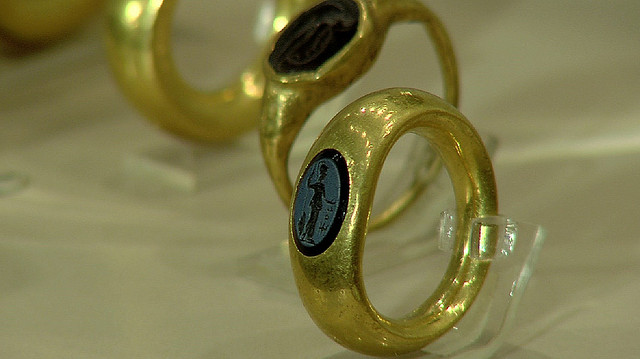The images you'll see as you scroll down to the current text are all part of the story telling in my novel, Realms of Gold:Ritual to Romance.
Bianca Caldwell, pen name, Bianca Fiore, is a writer for an art magazine. In each of her monthly stories she describes an object used in ancient ritual.
Treasures of the Sarmatians: Gold Horses Earrings
These look like
little ermines nibbling at acorns. Russia is known for its ermines
even today.
Gold: stamping, soldering, forging, granulation, filigree
1st-5th Centuries A.D.
Gold: stamping, soldering, forging, granulation, filigree
1st-5th Centuries A.D.
Tarantella Ballet
Tarantella
The nimble quickness of Tarantella provides a virtuosic showcase. The profusion of steps and the quick changes of direction this brief but explosive pas de deux requires typify the ways in which Balanchine expanded the traditional vocabulary of classical dance.
Tarantella ballet choreographed by New York City Ballet co-founder and balletmaster George Balanchine to Louis Moreau Gottschalk's Grande Tarantelle, Op. 67, reconstructed and orchestrated for piano and orchestra by Hershy Kay. The premiere took place January 7, 1964, at the City Center of Music and Drama, New York.
The nimble quickness of Tarantella provides a virtuosic showcase. The profusion of steps and the quick changes of direction this brief but explosive pas de deux requires typify the ways in which Balanchine expanded the traditional vocabulary of classical dance.
Tarantella ballet choreographed by New York City Ballet co-founder and balletmaster George Balanchine to Louis Moreau Gottschalk's Grande Tarantelle, Op. 67, reconstructed and orchestrated for piano and orchestra by Hershy Kay. The premiere took place January 7, 1964, at the City Center of Music and Drama, New York.
Courtship Tarantella
This Courtship Tarantella, danced at festivals, is from Monte Sant' Angelo, on the Gargano, in Puglia
The Tarantella and the Myth of Arachne
To my blog followers. The Gold Rush is over—at least for a while.
Realms of Gold is partially set near the archaeological site of the legendary, gold -loving city of Sybaris located In Magna Graecia, the Greater Greece of southern Italy.
Alessandra Belloni and her group, Giullari di Piazza are artists in residence of the Cathedral of St. John the Divine, New York City. I first saw her Dance of the Spider on a warm summer night in the gardens of the Hammer Museum, Los Angeles. She reminded me of a maenad on a Grecian urn. It was unforgettable evening. Belloni and her ensemble have created a series of full-length presentations based on the folk myths and rituals of southern Italy. She is an expert tambourine player, percussionist, vocalist, dancer and actress and has gained world-side acclaim.
I am including this video (ten minutes long, but just watching a part will give you an idea of what the real tarantella is about.
The Tarantella and the Myth of Arachne
The tarantella, the ritual dance of the spider, is an important part of the narrative in my novel. The dance derives from the myth of Arachne, who angered the goddess Athena, by winning a weaving contest. In her rage, Athena changed Arachne into a spider and, forever after, Arachne was doomed to weave her web.
There are other tarantellas-- the Neapolitan courtship dances as well as the simple tarantellas still danced at Italian weddings. However, the original "magico-religious" tarantella is a solo dance performed to rid the body of the venom of the spider through perspiration, delirium, rapid, sometimes contortive movements. The dance was believed to be a cure for the behavior of neurotic women.
The oldest documents mentioning the relationship between musical exorcism and the tarantula are dated around 1100 BC The tarantella is believed to be a remnant of the cult of Dionysus driven underground. These Dionysian-Bacchanalian rites were later suppressed by the Roman Senate. The name of the dance, tarantella, is thought to be derived from the Spartan city of Taranto, in Apulia, Italy.
Alessandra Belloni and her New York-based band, I Guillari di Piazza (Players of the Square), are artists in residence at the Cathedral of St. John the Divine in New York City
Realms of Gold is partially set near the archaeological site of the legendary, gold -loving city of Sybaris located In Magna Graecia, the Greater Greece of southern Italy.
Alessandra Belloni and her group, Giullari di Piazza are artists in residence of the Cathedral of St. John the Divine, New York City. I first saw her Dance of the Spider on a warm summer night in the gardens of the Hammer Museum, Los Angeles. She reminded me of a maenad on a Grecian urn. It was unforgettable evening. Belloni and her ensemble have created a series of full-length presentations based on the folk myths and rituals of southern Italy. She is an expert tambourine player, percussionist, vocalist, dancer and actress and has gained world-side acclaim.
I am including this video (ten minutes long, but just watching a part will give you an idea of what the real tarantella is about.
The Tarantella and the Myth of Arachne
The tarantella, the ritual dance of the spider, is an important part of the narrative in my novel. The dance derives from the myth of Arachne, who angered the goddess Athena, by winning a weaving contest. In her rage, Athena changed Arachne into a spider and, forever after, Arachne was doomed to weave her web.
There are other tarantellas-- the Neapolitan courtship dances as well as the simple tarantellas still danced at Italian weddings. However, the original "magico-religious" tarantella is a solo dance performed to rid the body of the venom of the spider through perspiration, delirium, rapid, sometimes contortive movements. The dance was believed to be a cure for the behavior of neurotic women.
The oldest documents mentioning the relationship between musical exorcism and the tarantula are dated around 1100 BC The tarantella is believed to be a remnant of the cult of Dionysus driven underground. These Dionysian-Bacchanalian rites were later suppressed by the Roman Senate. The name of the dance, tarantella, is thought to be derived from the Spartan city of Taranto, in Apulia, Italy.
Alessandra Belloni and her New York-based band, I Guillari di Piazza (Players of the Square), are artists in residence at the Cathedral of St. John the Divine in New York City
Treasures of the Sarmatians: Bracelets
Bracelets, 4th-6th Centuries A.D.
Gold, jade, garnet, topaz, enamel: forging, engraving, granulation, encrustation
Signing Realms of Gold in Exeter Chapel
The Chapel, Exeter College, Oxford--tapestry is by Burne-Jones-William Morris , both had been students at Exeter College
Tome Tender Reviews Realms of Gold
Realms of Gold by Terry Stanfill
by Terry Stanfill
My rating: 4 of 5 stars
Terry Stanfill’s Realms of Gold is part suspense, part mystery, and part romance all in one book, so pay attention to the details, and trust me, realms of Gold is full of rich detail! Giovanni Di Serlo and Bianca Caldwell meet at a wedding in Italy, discovering how much they have in common. He is an Italian archeologist working on a secret dig in Puglia, Italy while she writes articles for an art magazine, getting her inspiration from dreams and visions-a gift passed down through the generations. Bianca is immediately smitten with Giovanni, who is reluctant to share more than a polite cup of coffee with this plain woman. Their common ground is the beauty of history and its many mysteries waiting to be uncovered. When Bianca’s dreams and visions of a woman named Zatoria cause her to contact Giovanni after they have each returned to their own lives, they begin a journey together that leads them on a path that connects the Vix Krater, an ancient bronze vessel to the legend of King Arthur and the Holy Grail. As these two become more involved in ancient history, they begin a romantic journey of their own that binds their hearts as well as their minds.
Terry Stanfill takes us into the hearts and minds of these two people as they travel Europe on a quest through time unlocking the doors of history in this character driven novel. Her writing is dreamlike, with rich scenes, and intense emotional tension. The pace is relaxed and slowly pulls us through on soft waves of well-written prose. As history unfolds, it is plain to see that Terry Stanfill has done her homework in creating this well-crafted tale, making it an intriguing historical read and an unconventional romance with a taste of mystery and quiet adventure.
A Celtic solid gold bracelet, Iron Age, circa 1000 B.C. Just sold in London.
LONDON.- An exquisite solid gold bracelet made over 3000 years ago at the dawn of the European Iron Age was among the highlights of the Antiquities sale on Thursday 2 May, at Christie’s South Kensington.

The heavy gold bracelet ... features superb works of art that embrace the cultures of Egypt, Greece, Rome and the Near East.
The design of the bracelet, made with over half a kilo of high-purity gold, clearly demonstrates the technological advancements of the Iron Age. The new use of iron around 1000 B.C. brought two huge benefits to the goldsmith. Furnaces capable of achieving the high temperatures necessary for iron production provided craftsmen with the technology to melt larger masses of gold than before, while tools made out of the iron itself allowed craftsmen to become increasingly bold and ambitious with their designs.
The stunning piece of jewellery, featuring an intricate geometric pattern, was originally discovered in Portugal, part of the Iberian Peninsula where other museum-quality pieces were also uncovered during the mid-20th Century.
Subscribe to:
Posts (Atom)


























